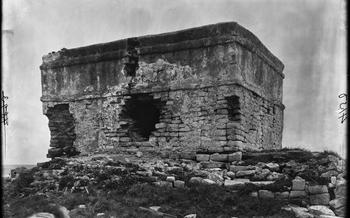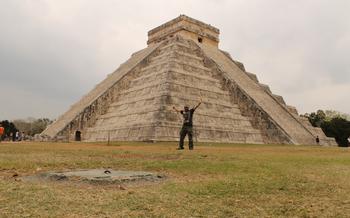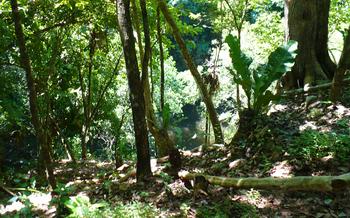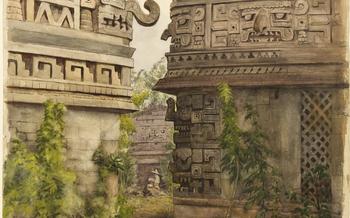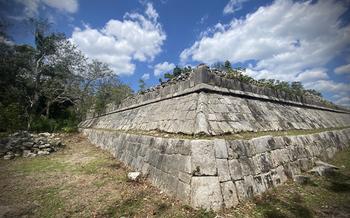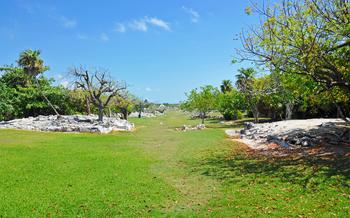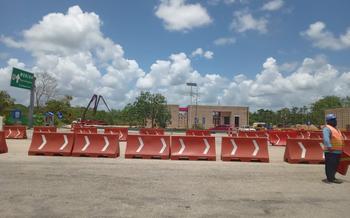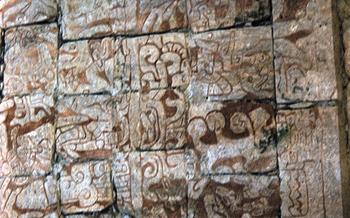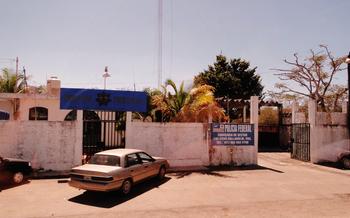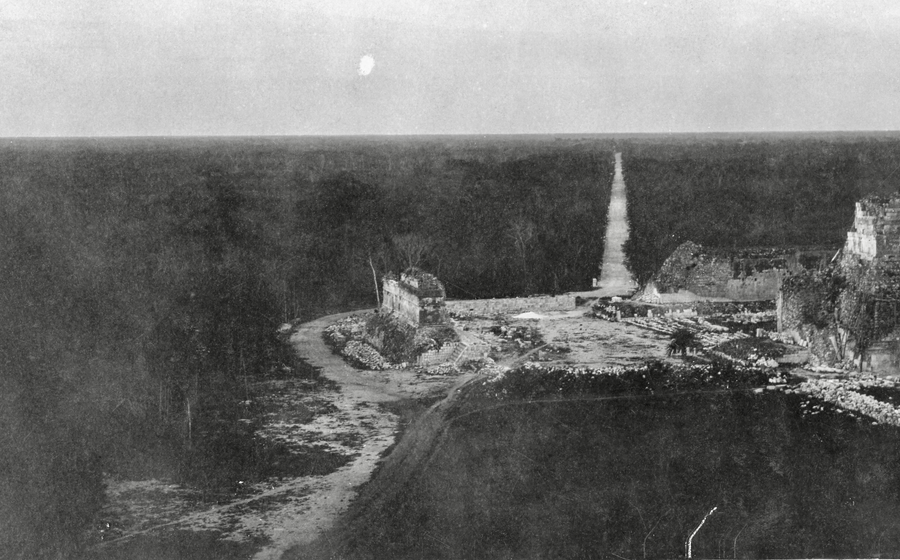
Cenote Chikin Ha
- Chichen Itza and the Cenote Chikin Ha: An Ancient Wonder and a Natural Gem
- Exploring Chichen Itza: Unveiling the Secrets of the Maya
- Step into the Sacred Cenote Chikin Ha: A Place of Rituals and Mystery
- Discovering the Beauty of the Cenote: A Natural Oasis
- Unforgettable Experiences at Chichen Itza: Beyond History and Nature
- Practical Information for Visitors: Planning Your Trip to Chichen Itza
- Essential Tips for Exploring Chichen Itza: Safety and Etiquette
- Capturing the Essence of Chichen Itza: Photography and Videography
- Maya Gastronomy: Tantalizing Flavors of the Region
- Shopping for Souvenirs: Preserving the Cultural Heritage
- Sustainable Tourism: Protecting the Legacy of Chichen Itza
- Historical Context: Understanding the Maya Civilization
- Cultural Experiences: Connecting with Maya Traditions
- Insider Tip: Unveiling the Secrets of the Night Sky
Chichen Itza and the Cenote Chikin Ha: An Ancient Wonder and a Natural Gem
In the heart of Mexico's Yucatán Peninsula, the ancient city of Chichen Itza stands as a testament to the ingenuity and artistry of the Maya civilization. Among its many wonders, the Cenote Chikin Ha, a natural sinkhole with crystal-clear waters, holds a special place. Its beauty and spiritual significance make it a must-visit destination for anyone seeking a journey that blends history, nature, and cultural immersion.
As a travel enthusiast who has explored many corners of the world, I was particularly drawn to the allure of Chichen Itza and the Cenote Chikin Ha. The opportunity to immerse myself in Maya culture, unravel the mysteries of this ancient city, and witness the breathtaking beauty of the cenote was irresistible. In this article, I'll take you on a journey through these two iconic destinations, sharing my experiences, practical tips, and insights into the history, culture, and natural wonders that await you.
Exploring Chichen Itza: Unveiling the Secrets of the Maya
Chichen Itza, a UNESCO World Heritage Site, stands as a testament to the architectural prowess and cultural significance of the ancient Maya civilization. Its iconic pyramid, El Castillo (Temple of Kukulcán), dominates the skyline, beckoning visitors to unravel the mysteries that lie within.
The Great Ball Court, the largest in Mesoamerica, speaks to the Maya's passion for sports and ritual competition. Its sloping sides and carved stone rings hint at the fierce contests that once took place here.
The Temple of a Thousand Warriors, with its intricate bas-reliefs depicting Maya warriors and deities, offers a glimpse into the military and religious life of the city.
The Sacred Cenote, a natural sinkhole considered a sacred site by the Maya, holds a special place in the city's history. Offerings of jade, gold, and human remains discovered within its depths reveal the cenote's importance in Maya religious ceremonies and cosmology.
Exploring Chichen Itza is like stepping back in time, immersing oneself in the grandeur and artistry of a civilization that thrived centuries ago. Each structure, each carving, each artifact tells a story of a people who left an indelible mark on the world's cultural heritage.
Step into the Sacred Cenote Chikin Ha: A Place of Rituals and Mystery
The Cenote Chikin Ha, located within the grounds of Chichen Itza, is a natural wonder that holds deep spiritual and religious significance for the ancient Maya. Formed by the collapse of a limestone bedrock, the cenote is a sinkhole that reveals a subterranean world of crystal-clear waters and lush vegetation.
The Maya believed that cenotes were gateways to the underworld, Xibalba, and that they were portals to communicate with the gods. The Cenote Chikin Ha was particularly sacred, as it was believed to be the entrance to the afterlife. Offerings of precious objects, such as jade, gold, and ceramics, were thrown into the cenote as a way to honor the gods and ensure a safe passage to the next world.
Legends and myths surround the cenote, adding to its mystical aura. One legend tells the story of a beautiful Maya princess who was sacrificed in the cenote to appease the rain god Chaac. Another myth speaks of a hidden chamber beneath the cenote that contains the remains of a powerful Maya ruler, guarded by supernatural beings.
The Cenote Chikin Ha is not only a place of reverence but also a place of beauty. Its crystal-clear waters, surrounded by lush vegetation, create a breathtaking sight. The cenote is also home to a variety of aquatic life, including colorful fish, turtles, and even crocodiles. Visitors can swim, snorkel, or dive in the cenote, offering a chance to explore its depths and discover its hidden wonders.
Discovering the Beauty of the Cenote: A Natural Oasis
The Cenote Chikin Ha is a breathtaking natural wonder that complements the historical significance of Chichen Itza. Its crystal-clear waters invite visitors to take a refreshing dip and marvel at the intricate underwater world. The cenote's lush vegetation, with its vibrant green ferns and cascading vines, creates a serene and picturesque setting.
The cenote is home to a diverse array of aquatic life, including colorful fish, turtles, and exotic birds. Snorkeling or diving in the cenote offers a chance to witness this vibrant underwater ecosystem up close. The crystal-clear water provides excellent visibility, allowing visitors to admire the intricate coral formations and observe the graceful movements of fish darting in and out of the underwater caves.
For those seeking a more relaxing experience, simply floating in the cenote's tranquil waters is a blissful way to soak in the natural beauty and tranquility of the surroundings. The cenote's refreshing waters provide a welcome respite from the heat and humidity of the Yucatán Peninsula, making it an ideal spot to unwind and rejuvenate.
Unforgettable Experiences at Chichen Itza: Beyond History and Nature
Beyond its historical and natural significance, Chichen Itza offers a range of unforgettable experiences that immerse visitors in the rich culture and traditions of the Maya civilization. One of the highlights is the opportunity to witness the equinox celebrations, which take place twice a year during the spring and autumn equinoxes. During these special events, the sun aligns perfectly with the pyramid El Castillo, creating a mesmerizing light and shadow effect known as the "descent of Kukulcán." It's a breathtaking sight that attracts thousands of visitors from around the world.
In addition to the equinox celebrations, Chichen Itza hosts various cultural performances and traditional ceremonies that showcase the vibrant heritage of the Maya people. These events include traditional dances, music, and reenactments of ancient rituals, providing visitors with a glimpse into the spiritual and cultural practices of the Maya.
To enhance the experience and gain deeper insights into Maya culture, it's highly recommended to hire a knowledgeable guide. Professional guides can provide detailed explanations of the site's history, symbolism, and significance, making the visit more enriching and meaningful. They can also help navigate the crowds and point out hidden details that visitors might miss on their own.
Whether you're attending a special event, witnessing the equinox phenomenon, or simply exploring the site with a guide, Chichen Itza offers a multitude of unforgettable experiences that go beyond its historical and natural wonders, allowing visitors to connect with the living legacy of the Maya civilization.
Practical Information for Visitors: Planning Your Trip to Chichen Itza
Getting to Chichen Itza: Chichen Itza is easily accessible from popular tourist destinations in Mexico. From Cancun, you can take a direct bus or join a guided tour. If you're driving from Playa del Carmen, the journey takes about two hours on well-maintained roads.
Best Time to Visit: The best time to visit Chichen Itza is during the dry season, which runs from November to April. During this period, the weather is mostly sunny and pleasant, with little chance of rain. However, do note that this is also the peak tourist season, so expect crowds. If you prefer a quieter experience, consider visiting during the shoulder months of May or October.
Accommodation Options: There are various accommodation options available near Chichen Itza to suit different budgets and preferences. For a luxurious stay, consider the upscale Mayaland Hotel, located just a few steps from the ruins. For a more budget-friendly option, there are several hostels and guesthouses within walking distance of the site.
Packing Essentials: When packing for your trip to Chichen Itza, remember to bring comfortable walking shoes, as you'll be doing a lot of walking on uneven surfaces. Sunscreen, sunglasses, and a hat are essential to protect yourself from the sun. Insect repellent is also recommended to keep mosquitoes and other insects at bay.
Essential Tips for Exploring Chichen Itza: Safety and Etiquette
Visiting Chichen Itza requires adherence to certain safety guidelines and respectful behavior to ensure a safe and enjoyable experience for all. Sturdy shoes are essential for navigating uneven surfaces and climbing steps. Climbing on structures is strictly prohibited to prevent accidents and preserve the integrity of the ancient ruins.
Appropriate attire is recommended, considering the sacred nature of the site. Visitors should dress respectfully, avoiding revealing or overly casual clothing. While exploring the site, it is important to be mindful of other visitors, avoiding blocking pathways or obstructing views.
To make the most of the experience, consider hiring a knowledgeable guide. Guides can provide valuable insights into the history, culture, and significance of Chichen Itza, enhancing the understanding and appreciation of the site.
Crowds can be overwhelming, especially during peak tourist seasons. To avoid the hustle and bustle, consider visiting early in the morning or during the shoulder months (April-May and September-October).
Respecting the cultural and religious significance of Chichen Itza is paramount. Visitors should refrain from touching or defacing any structures or artifacts. Photography is permitted, but it is essential to respect the privacy of others and obtain permission before photographing people.
Capturing the Essence of Chichen Itza: Photography and Videography
Chichen Itza's grandeur and intricate details demand to be captured through the lens of a camera. Whether you're a seasoned photographer or simply seeking to preserve your memories, here are some tips to help you create stunning visuals.
Essential Camera Gear: - Camera: A DSLR or mirrorless camera with interchangeable lenses is ideal for capturing high-quality images. - Lenses: Bring a wide-angle lens to capture sweeping landscapes and a telephoto lens for close-up details. - Tripod: A sturdy tripod is crucial for sharp shots, especially in low-light conditions.
Best Spots for Photography: - El Castillo: Capture the iconic pyramid from various angles, experimenting with different perspectives. - Great Ball Court: Frame the colossal court with the towering walls and stone rings as a backdrop. - Temple of a Thousand Warriors: Photograph the intricate carvings and sculptures adorning the temple's columns. - Sacred Cenote: Capture the mystical beauty of the cenote, with its crystal-clear waters and lush vegetation.
Respecting Others and the Site: - Ask Permission: Before photographing people, always ask for their consent, especially when capturing portraits. - Avoid Flash: Using flash photography can be disruptive to other visitors and damage sensitive artifacts. - Stay on Designated Paths: Respect the site's fragile ecosystem by staying on marked trails and avoiding climbing on structures.
Additional Tips: - Golden Hour Magic: Visit during sunrise or sunset to capture the warm, golden light that casts a magical glow on the ruins. - Experiment with Angles: Play with different angles and perspectives to create unique and captivating shots. - Capture Details: Zoom in to capture intricate carvings, sculptures, and architectural elements that tell stories of the past. - Time-Lapse and Astrophotography: Consider setting up a time-lapse to capture the changing light and shadows throughout the day or try your hand at astrophotography for a breathtaking view of the Milky Way above the ruins.
Maya Gastronomy: Tantalizing Flavors of the Region
The Yucatán Peninsula is a culinary paradise, where ancient Maya traditions blend harmoniously with local ingredients to create a unique and flavorful cuisine. As you explore Chichen Itza, don't miss the opportunity to savor the tantalizing dishes that reflect the region's rich history and culture.
Venture into the local restaurants or food stalls near the site and indulge in authentic Maya delicacies like cochinita pibil, a slow-roasted pork dish cooked in banana leaves. The smoky, tender meat, marinated in achiote paste and spices, is a true culinary gem.
Another must-try is panuchos, a traditional Maya dish consisting of handmade corn tortillas filled with black beans and topped with shredded turkey or chicken, lettuce, tomato, and pickled red onions. The combination of flavors and textures is simply irresistible.
For a vegetarian delight, try papadzules, a dish made with corn tortillas rolled up and filled with a flavorful mixture of eggs, squash seeds, and tomatoes, all bathed in a rich tomato sauce. The result is a symphony of flavors that will leave you craving more.
As you savor these culinary delights, take the time to learn about the significance of traditional Maya cooking techniques and the use of local spices and flavors. Maya cuisine is not just about taste; it's a reflection of the region's cultural identity and heritage.
Shopping for Souvenirs: Preserving the Cultural Heritage
At Chichen Itza, you'll find a vibrant array of souvenirs that showcase the rich cultural heritage of the Maya civilization. Supporting local artisans and purchasing authentic Maya crafts is not only a cherished way to remember your visit but also contributes to preserving this ancient culture's legacy.
One of the best places to shop for souvenirs is the bustling market located just outside the main entrance to Chichen Itza. Here, you'll find stalls brimming with colorful textiles, intricate pottery, and hand-carved wooden figurines depicting ancient Maya deities and symbols. The artisans who create these beautiful pieces take great pride in their work, and each item is a testament to their skill and dedication.
When shopping for souvenirs, it's essential to be mindful of authenticity. Look for shops that display the "Hecho en Mexico" (Made in Mexico) label, ensuring that you're buying genuine Maya crafts. Avoid mass-produced souvenirs that may not accurately represent the region's cultural heritage.
By supporting local artisans and purchasing authentic souvenirs, you play a vital role in preserving the cultural heritage of Chichen Itza and ensuring that future generations can continue to appreciate the beauty and significance of Maya art and craftsmanship.
Sustainable Tourism: Protecting the Legacy of Chichen Itza
Chichen Itza is a priceless cultural and natural treasure that requires our collective efforts to preserve for future generations. As responsible travelers, we have a duty to minimize our environmental impact and support sustainable tourism practices that protect the site's integrity. Simple actions like using reusable water bottles, avoiding single-use plastics, and respecting the wildlife go a long way in preserving the delicate ecosystem of Chichen Itza. Additionally, supporting local initiatives that promote sustainable tourism and community development helps ensure that the benefits of tourism are shared equitably. By embracing sustainable practices, we can ensure that Chichen Itza continues to inspire and awe visitors for years to come.
During my visit to Chichen Itza, I was particularly impressed by the efforts of a local organization dedicated to sustainable tourism. They had set up recycling stations throughout the site and provided educational materials to visitors about the importance of responsible tourism. I was also encouraged to see that many of the vendors selling souvenirs and snacks were using biodegradable packaging and supporting local artisans. These initiatives demonstrated a genuine commitment to preserving the cultural and natural heritage of Chichen Itza while ensuring that tourism benefits the local community.
As travelers, we have a responsibility to be mindful of our impact on the destinations we visit. By embracing sustainable practices and supporting local initiatives, we can help protect the legacy of Chichen Itza and ensure that it remains a source of wonder and inspiration for generations to come.
Historical Context: Understanding the Maya Civilization
Beneath the awe-inspiring structures of Chichen Itza lies a rich and captivating history, deeply intertwined with the Maya civilization. The Maya, renowned for their advanced knowledge in astronomy, mathematics, and architecture, flourished in Mesoamerica for over 2,000 years. Chichen Itza, one of the largest and most prominent Maya cities, played a crucial role in the cultural and political landscape of the region.
During its peak in the Late Classic period (600-900 AD), Chichen Itza emerged as a major political and economic center, exerting influence over a vast territory. The city was renowned for its architectural marvels, including the iconic pyramid El Castillo, a testament to Maya engineering prowess. Its strategic location at the intersection of major trade routes contributed to its prosperity and cosmopolitan character.
The Maya civilization faced significant challenges and upheavals throughout its history, including droughts, political conflicts, and the eventual collapse of the Classic period. However, their cultural legacy endured, and Chichen Itza continued to be an important center during the Post-Classic period (900-1521 AD). The city eventually declined due to a combination of factors, including internal conflicts, environmental changes, and the arrival of the Spanish conquistadors in the 16th century.
Understanding the historical context of the Maya civilization is essential for fully appreciating the significance of Chichen Itza. By delving into their rich history, we gain insights into the cultural, intellectual, and artistic achievements of this remarkable civilization.
Cultural Experiences: Connecting with Maya Traditions
Beyond exploring ancient ruins, visitors to Chichen Itza have the opportunity to delve deeper into Maya culture and traditions through various immersive experiences. Attending cultural events and workshops allows tourists to witness and participate in traditional Maya music, dance, cuisine, and crafts. These events provide a vibrant platform for local artists and performers to showcase their talents and share their cultural heritage with visitors. It is important to approach these experiences with respect and sensitivity, acknowledging the ongoing significance of Maya traditions within the community. By engaging with Maya culture in a meaningful way, visitors can gain a deeper understanding of the rich history and vibrant traditions that continue to shape the region.
Insider Tip: Unveiling the Secrets of the Night Sky
Beyond the historical and natural wonders of Chichen Itza, there lies a hidden gem for astronomy enthusiasts and nature lovers alike. As night falls, the site transforms into a celestial spectacle, offering a breathtaking view of the Milky Way in all its glory. The Maya held a profound understanding of astronomy and celestial events, which played a significant role in their culture and daily lives.
To experience this celestial wonder, plan your visit during the dry season, typically from November to April, when the skies are clear and free of clouds. Head to the open areas within the site, away from the main structures, to avoid light pollution. As you lie down on the ancient ground, the Milky Way stretches across the sky like a luminous river, revealing countless stars and constellations.
Among the constellations, look out for the Pleiades, known as Tzab in Maya, which held special significance as a marker for the agricultural cycle. The Maya also observed the movements of Venus, which they believed was a powerful deity associated with war and rulership.
Stargazing at Chichen Itza is an awe-inspiring experience that connects you with the ancient Maya and their profound connection to the cosmos. As you immerse yourself in the tranquility of the night sky, you'll gain a deeper appreciation for the harmony between humanity and the universe.
